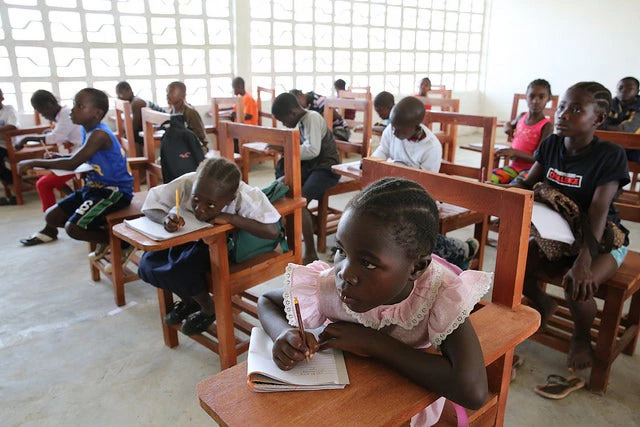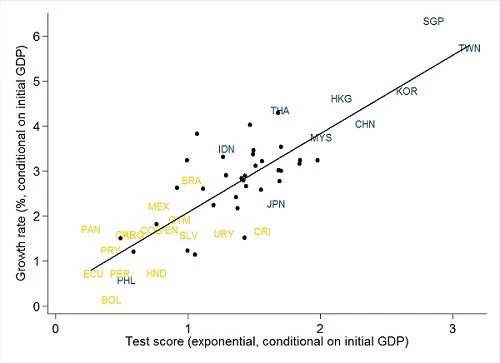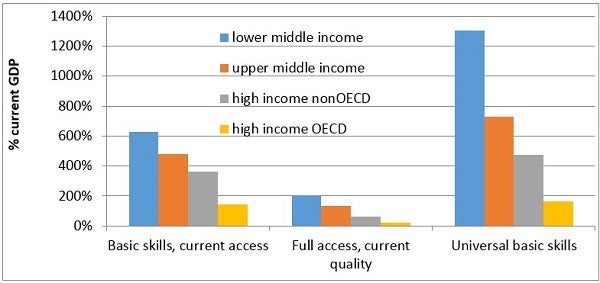
Ed: This guest post is by Professor Eric A. Hanushek, a Paul and Jean Hanna Senior Fellow at the Hoover Institution of Stanford University. Join us online on January 28, 2016 to listen to Prof. Hanushek as he discusses his latest book “The Knowledge Capital of Nations”.
In September 2015, the United Nations adopted an aggressive development agenda that included 17 separate Sustainable Development Goals (SDGs) designed to guide investment and development over the next 15 years. Two of these assume particular importance because they will determine whether or not the other 15 can be achieved.
Without economic growth that expands the size of the pie, there is little hope of reaching the desirable outcomes in terms of health, poverty, nutrition, and inclusion in improvements. And, without quality education, there is little hope of obtaining the requisite long run growth. The key, as research now indicates, is the amount of learning that goes on in schools, and this differs dramatically across countries.
Past efforts to expand education in developing countries have been less than completely successful, because they have put too much emphasis on access and time in school, and too little on the quality of any schooling. While there have been dramatic improvements in access to schools across developing regions, following the Millennium Development Goals, the story about learning of students is much less satisfactory. Developing countries continue to rank far behind the developed world in terms of measured cognitive skills, what we call the knowledge capital of nations.
Analysis that I have done with Ludger Woessmann ( The Knowledge Capital of Nations: Education and the Economics of Growth) shows that almost all of the variation in economic growth rates across nations can be explained by differences in knowledge capital. Indeed, some of the puzzles of historic growth patterns no longer look like puzzles when we take into the learning that takes place in the different schools found around the world.
What is driving the East Asia miracle? On the whole, East Asian kids learn more each year they are in school that those in other places, producing a highly skilled labor force. Why has growth in Latin America been so slow? Latin American students get much less out of a year of school than elsewhere.
Once the knowledge capital of the countries (measured by international test scores) is considered, these regions fit in with growth patterns elsewhere in the world, as seen in Figure 1. This figure plots how long run growth rates in real GDP per capita from 1960-2000 relate to knowledge capital (after allowing for difference in initial income in 1960). The East Asian and Latin American countries are highlighted. Moreover, once knowledge capital is considered, pure access as measured by years of schooling completed bears no relationship with long run growth.
One thing that we have also learned in looking at economic growth, and that is implicitly shown in Figure 1, is that “quality education” is defined through world economic competition. While individual countries may have views on what constitutes quality, what counts for economic outcomes is the knowledge and skills of the population as proxied by consistent international test scores such as PISA or TIMSS.
Figure 1. Knowledge Capital and Economic Growth

Note: The line shows the relationship between aggregate test scores for countries and their long run growth in real GDP/pop over the period 1960-2000. The underlying regression includes the level of GDP/pop in 1960 to reflect the fact that nations starting behind can grow rapidly by copying what is done in more advanced countries. Source: here .
It is also possible to put the SDGs into perspective by projecting the GDP improvements that would, according to historical growth patterns, result from improvements in access and quality of schooling consistent with the goals.
The SDGs call for all youth to be expected to complete quality secondary schooling by 2030, although quality is left quite vague. Here we adopt a quantitative international standard for quality: all students show basic skills, which we define as achieving level one on the PISA tests. This standard indicates that 15-year-olds demonstrate elementary skills to read and understand simple texts and master basic mathematical and scientific concepts and procedures. (See: Universal basic skills: What countries stand to gain).
Using the basic knowledge capital-growth relationship in Figure 1, it is possible to project future growth and GDP under different improvement scenarios: bringing just current students up to basic skill level; expanding to universal access at current achievement levels; and universal basic skills (doing both).
We assume that each goal is reached by 2030, and we project growth over an 80-year period, the expected life of somebody born today. Future gains in GDP are discounted at three percent to yield the present value of growth, so these projections can be readily compared to current economic well-being.
Figure 2 shows the gains for 76 countries at different levels of development. For the lower middle income countries (that have participated in the international testing), bringing the 80 percent of youth currently completing secondary school up to the level of basic skills would on average yield economic gains that are six times the current level of GDP, while expanding to universal access at current quality yields gains that are one-third as large. Reaching universal basic skills are estimated to achieve gains that are 12 times the current GDP.
Figure 2. Access, Skills, and Economic Outcomes

Note: Present value of added GDP from improvements in education quality, in school access, and in universal achievement of basic skills by countries at different income levels. Source: here.
Richer countries gain less simply because they are closer to universal access and have higher achievement. But the gains are still substantial; universal basic skills for upper middle income countries would average over seven times current GDP. For upper income OECD countries, the gains come almost entirely from bringing up achievement at the bottom end of the distribution, but they still amount to 1.5 times current GDP.
In these estimates, many developing countries are left out simply because they have not participated in the international testing. Almost certainly these countries face more substantial quality and access challenges than the included low income countries.
There is a simple message: achieving the SDGs requires improving the quality of schools around the world, because otherwise the size of the pie is unlikely to expand substantially, thus making it difficult, if not impossible, to meet the poverty, health, nutrition, and inclusiveness goals. Moreover, quality requires explicit measurement by international benchmarks because local definitions of quality are unlikely to produce internationally competitive labor forces.
Find out more about the World Bank Group’s work on education on Twitter and Flipboard .
View the video recording of the book launch


Join the Conversation